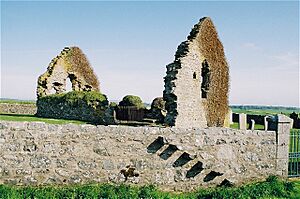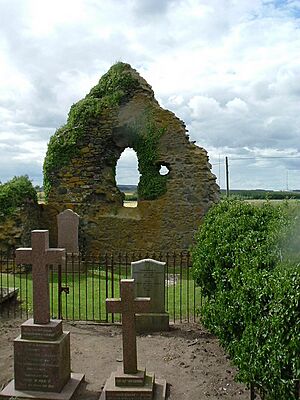Rattray, Aberdeenshire facts for kids
Rattray is a historic area in Scotland. It was once a busy town, or "burgh," located near a place called Crimond. People have lived here for a very long time, since about 4000 BC! In 1564, Mary, Queen of Scots officially made Rattray a Royal Burgh. This was done to stop arguments between two powerful families, the Keiths and the Hays, about who was in charge of the area. Sadly, a big storm in the 1700s covered most of the old town with sand from the nearby dunes at Rattray Head. The town never fully recovered. Today, there is still a small modern village in the area.
Contents
What to See in Rattray
Rattray has some interesting historical spots and natural features.
The Old Harbour and Loch Strathbeg
Close to Rattray is a large body of water called Strathbeg Bay. It was once an open area connected to the sea, like a river mouth, where trading ships could easily sail. This made the Starny Keppie harbour a very busy place, and Rattray grew around it.
However, by 1654, the harbour started to fill up with sand and mud, a process called "silting up." Then, around 1720, a huge storm hit. The shifting sands completely cut off Strathbeg Bay from the sea, turning it into a lake called Loch Strathbeg. The storm even trapped a small ship full of roof slates inside the new lake! These slates were later used to build roofs in nearby Crimond and Haddo House.
Protecting the Harbour: Rattray's Castles
The old harbour was protected by two strong castles. These were part of a group known as "the Nine Castles of Knuckle."
- The Castle of Rattray belonged to the Comyn family. It stood on a hill called Castlehill, which was a rocky point right on the coast next to the harbour.
- The other castle was Lonmay Castle.
St Mary's Chapel
You can still see the ruins of St Mary's Chapel today. It was built by the Comyn family as their own private church at the same time they built the Castle of Rattray. It's a very old and interesting ruin.
St Fergus Church
The current St Fergus Church was built much later, in 1868. It was designed by an architect named James Matthews. The church has a special bell tower, called a "bellcote," which dates all the way back to 1644! This bellcote was moved from an even older church that was abandoned in 1616. The churchyard wall, built in 1751, is still there. It includes an arched gate, a small building called a "morthouse" (used to guard graves), and many old gravestones.
Battle Fauld: A Historic Site
To the west of Rattray, near Loch Strathbeg, is a historic place called Battle Fauld. Its name probably comes from a battle that happened there long ago. People believe it was a fight against the Danes during their invasions of Scotland. In fact, people who studied the local language in 1888 found that many words and pronunciations were very similar to old Danish or Norwegian words. They said the language features were "thoroughly Norse," meaning they came from the Norse people (like the Vikings).
A famous old song, or "ballad," called Sir James the Rose is set in Battle Fauld. The story says that Sir James the Rose is buried there.



